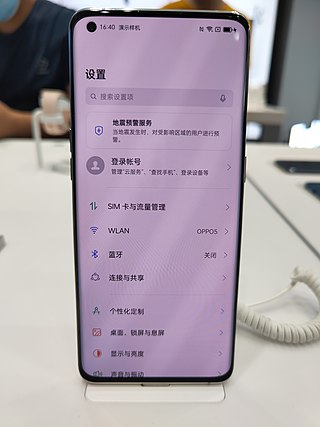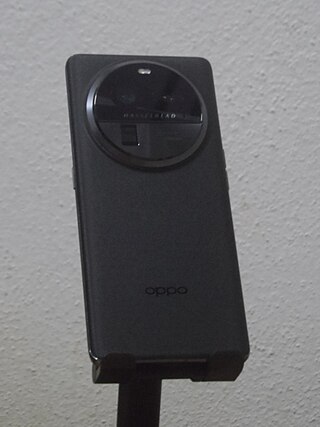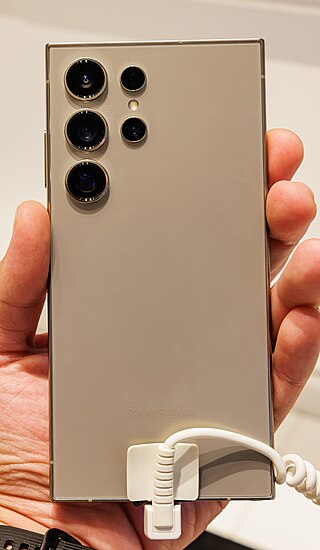
The Samsung Galaxy Note series was a line of high-end flagship Android phablets and smartphones developed and marketed by Samsung Electronics. The line is primarily oriented towards pen computing; all Galaxy Note models shipped with a stylus pen, called the S Pen, and incorporate a pressure-sensitive Wacom digitizer. All Galaxy Note models also include software features that are oriented towards the stylus and the devices' large screens, such as note-taking, digital scrapbooking apps, tooltips, and split-screen multitasking. The line served as Samsung's flagship smartphone model, positioned above the Galaxy S series.
The Sony Xperia T2 Ultra is an Android smartphone developed by Sony Mobile Communications. It was announced in January 2014 and was released in March 2014.
Oppo phones are smartphones produced by the partially state-owned Chinese company Oppo, running in several countries.

The Huawei Pura series is a line of high-end and medium-range HarmonyOS smartphones produced by Huawei. The P series was formerly marketed as part of Huawei's larger Ascend brand, and some models were called P smart.

The Sony Xperia 1 is an Android smartphone made by Sony. Part of Sony's flagship Xperia series, the device was announced to the public at a press conference held at the annual 2019 Mobile World Congress event on February 25, 2019. It’s the world's first smartphone with an ultrawide 21:9 aspect ratio 4K HDR OLED display, dubbed Cinema Wide, and Sony's first triple-lens camera system featuring Eye AF eye-tracking technology seen in the company's Alpha line of professional-grade cameras. The Xperia 1 was later joined by a more compact device, the Xperia 5, which was revealed on 5 September 2019. Compared to the Xperia 1, the Xperia 5 has a smaller 1080p screen, a smaller battery, and a non-centrally aligned camera module.
Motorola One is a series of Android phones developed by Motorola Mobility. The Motorola One series, first launched in 2018 as upper mid-range replacements for the Moto X4, was originally a series of phones featuring the Android One version of Android and mostly made available in Asian and European markets. However, the latest Motorola One series phones like Motorola One Zoom does not support Android One.
Oppo Reno2 is a line of Android smartphones manufactured by Oppo as the successor to the Oppo Reno series. Launched on 28 August 2019 in India, it comprises the Oppo Reno2, Reno2 F, and Reno2 Z. Like their flagship predecessors, the Reno2 phones feature pop-up selfie cameras to provide edge-to-edge displays.
The OPPO A9 2020, along with OPPO A5 2020, are the successors to the OPPO A series. It was launched on 11 September 2019 in India and equipped with 48MP Ultra Wide Quad Camera, 5000 mAh Ultra Battery and reverse charging capability.
The Oppo Find X2 and Find X2 Pro are Android-based smartphones manufactured by Oppo, unveiled on 6 March 2020.

Redmi K30 Pro is a line of Android-based smartphones manufactured by Xiaomi and marketed under its Redmi sub-brand. There are four models, the K30 Pro, K30 Pro Zoom, K30 Ultra and the POCO F2 Pro, which is a rebranded version of the K30 Pro.

Oppo Find X3 Series are Android-based smartphones manufactured by Oppo, succeeding the Find X2 Series

The Sony Xperia 1 III is an Android smartphone manufactured by Sony. Designed to be the new flagship of Sony's Xperia series, the phone was announced along with the compact flagship Xperia 5 III and the mid-range Xperia 10 III on April 14, 2021.
The Samsung Galaxy F62 is a mid-range Android smartphone manufactured by Samsung Electronics as part of its Galaxy F series. It is the second phone to be released in the series. It has a 7000 mAh battery, a quad camera setup with a 64 MP main camera, as well as a 12 MP ultrawide camera, a 5 MP macro camera and a 5 MP depth sensor, a 6.7 in (17 cm) Super AMOLED Plus display and the Exynos 9825 SoC previously used in the Samsung Galaxy Note 10 and Note 10+ flagship smartphones.

The Huawei P50 and P50 Pro are HarmonyOS-based high-end smartphones manufactured by Huawei. Unveiled on 21 July 2021, they succeed the Huawei P40 in the P series. In March 2023 Huawei released their successor Huawei P60 Series phones in China, and in May 2023 it released the Huawei P60 Pro in Europe.
Oppo Find X5 Series are Android-based smartphones manufactured by Oppo, succeeding the Find X3 Series. These phones were announced on 24 February 2022.

The Sony Xperia 1 IV is an Android smartphone manufactured by Sony. Launched on May 11, 2022, it succeeds the Xperia 1 III as the latest flagship of Sony's Xperia series. The device was announced along with the mid-range Xperia 10 IV, with expected release dates by June 2022 and as late as September 2022 for other markets including the US. US shipments were delayed and ultimately began in late October 2022.

The Oppo Find X6 is a series of two Android-based smartphones manufactured by Oppo as part of its flagship Find X series. Unveiled as successors to the Oppo Find X5 series, both phones were unveiled on 21 March 2023. Currently, the Find X6 series is available for sale only in mainland China.

The Samsung Galaxy S24 is a series of high-end Android-based smartphones designed, developed, manufactured, and marketed by Samsung Electronics as part of its flagship Galaxy S series. They collectively serve as the successor to the Samsung Galaxy S23 series. The phones were announced on January 17, 2024, at Galaxy Unpacked, alongside Galaxy AI, in San Jose, California. The phones were subsequently released on January 31, 2024.










